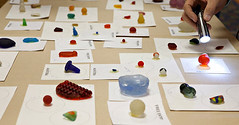
PREV ARTICLE
NEXT ARTICLE
FULL ISSUE
PREV FULL ISSUE
NOTES FROM E-SYLUM READERS: OCTOBER 24, 2010Michael E. Marotta writes: Former Mensa member Ginger Rapsus cautioned that the word "Mensa" is not "an acrostic." I would say "acronym." NASA is an acronym. An acrostic is more involved, typically using (from the Greek) a line of verse or any sentence and can employ any regular pattern of letters, such as first, third, or last. Edgar Allen Poe's "Valentine" to Joan of Arc is an acrostic: first letter of the first line; second letter of the next; etc. I am not a dealer, and not much of a collector of stuff. Like Walter Breen, I collect knowledge. Like Dick Johnson, I have some interest in codes, but unlike Walter Breen, I am not impressed with my own intelligence, but rather, daunted by the lack of it. My code is for convenience: I write the buy price twice, as letters. A=1, B=2, etc. For a coin that cost $51, I write EAZY. Jeffrey Zarit writes:
I object to anything connected with Walter Breen as he was a
CONVICTED PEDOPHILE. In my opinion, we should NOT celebrate anything
he did. Once convicted he gave up his rights to a civilized society.
Dennis Tucker writes: Here's an interesting article in the New York Times about the hobby community for sea glass --- and some reactions and opinions concerning fakes. Could the Chinese counterfeiters be far behind?
Here's an excerpt.
-Editor
At the meeting they trade shards of glass and porcelain, buy and sell sea glass jewelry and crafts, seek expert help identifying their finds and hear presentations on shipwrecks, the glass industry and other topics. Membership is growing and enthusiastic, Mary Beth Beuke of Sequim, Wash., the group's president, said in an interview, and sales of sea glass and its crafts are booming, even though the glass itself is getting harder to find. Though sea glass collectors talk about bottles, porcelain and other cargo lost in shipwrecks, most sea glass originated far more prosaically, in garbage dumped into the ocean or piled in coastal landfills. A blue shard may be the remains of a Noxzema jar or a bottle of Bromo-Seltzer; old Coke and beer bottles produce pale-green and dark-brown shards. Now this kind of dumping is mostly a thing of the past; bottles are made of thinner glass, and plastic has replaced glass in many products. But sea glass hunters do not necessarily limit themselves to glass. Some look for crockery shards, bottle stoppers, fragments of old toys, marbles virtually anything that left human hands to be tumbled by the sea.
To read the complete article, see:
From Junk to Collectible, Shaped by Time and Tide
(www.nytimes.com/2010/10/19/science/19glass.html)
The Numismatic Bibliomania Society is a non-profit organization promoting numismatic literature. See our web site at coinbooks.org. To submit items for publication in The E-Sylum, write to the Editor at this address: whomren@gmail.com To subscribe go to: https://my.binhost.com/lists/listinfo/esylum All Rights Reserved. NBS Home Page Contact the NBS webmaster 
|
